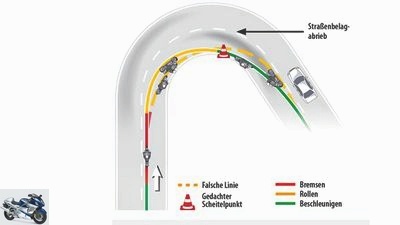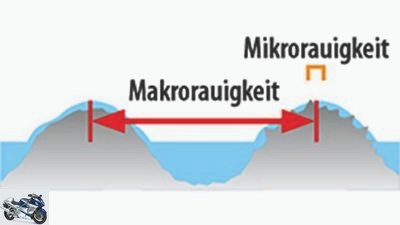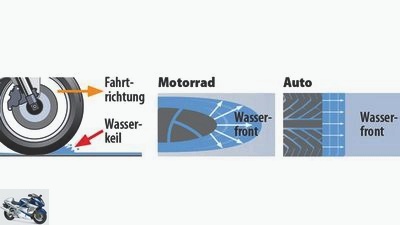Table of contents
- Less grip, more caution Driving in rain and wet
- Video: Riding a motorcycle in the wet
- Bends in the wet: drive soft lines
- Wet roads: danger of slipping
- Tire grip in the rain
- Aquaplaning on a motorcycle

Jahn
Sports & scene
Rain and wet
Less grip, more caution
Driving in rain and wet
Riding a motorcycle in the rain cannot always be avoided in this country. But with the right equipment and a realistic basic posture, a ride in the rain can also be managed safely and relaxed.
Nicolas Streblow
02.03.2018
Video: Riding a motorcycle in the wet
Most motorcyclists dream of having a dry, winding road with the finest asphalt all to themselves. Unfortunately, the reality in our part of the world looks very different. Because you can often choose neither the weather nor the degree of filling of the streets, if you want to move a little further away from the garage at home.
Rain is nasty, but not a big problem with good tires and clothing. Dry and, thanks to the anti-fog visor, also with good visibility, we should still slow down, because the wetness and lower temperatures mean that we have noticeably less grip available. Road markings and bitumen strips, cobblestones and manhole covers are even more slippery than when it is dry.
In addition, when we are wet, we cannot perceive such nasty traps as we may later even not notice an oil trail and the like. In dry phases, a lot of oil, dust and rubber debris are deposited in the pavement pores. The next time it rains, these substances are moistened and act like soft soap. Shortly after the start of the rain it is therefore slipperiest, and after a day of continuous rain the grip has often improved again.
Bends that can be taken with easy turns in the dry require sensitive use of the accelerator and brakes in the wet. When it rains, choosing the right line in curves is even more important than on a dry road. The trend is for a defensive driving style and a smooth, rounded driving style, at the same time good training for fine motor skills and concentration. The driving dynamics work no differently in the rain than on a dry road – with the crucial difference that processes such as accelerating, braking, turning and cornering have to be much smoother.
Anyone who turns sharply, brakes in a frightful manner or hastily turns the accelerator can suddenly overwhelm the tire grip on wet roads. Even when downshifting and engaging the clutch (tip: double-declutching!) You should go to work more gently; It is better to select a gear higher in the bends in order to accelerate smoothly and evenly from a lean angle with less speed.
In all of this, the following applies: stay relaxed. Especially when changing from dry to wet road surfaces, many people tend to tense up. And if you tense up, you will feel the motorcycle’s reactions later, maybe too late. In order to arrive safely in the rain, you should always consciously relax: drop your shoulders, loosen your upper lip, loosen your hands a little, take the tension off your buttocks. And maybe take a break and choose the pace so that you still feel comfortable despite the wetness. We recommend training under professional guidance in which braking maneuvers and cornering on wet, artificially watered road surfaces are practiced intensively.
To prevent the front wheel from slipping on the wet asphalt when braking hard, you have to pull the brake lever more carefully and build up the brake pressure quickly, but a little more slowly than in dry conditions. Stay a little below the personal, trained maximum value. Important: brake hard at the rear. Braking decelerations of up to 8.0 m / sec² can be achieved on non-slip asphalt. This corresponds to a braking distance from 100 km / h of 48 meters, i.e. only around eight meters longer than in the dry. However, the risk of the front wheel locking is relatively high, which requires a quick release and gripping. Or an effective ABS that can achieve amazing deceleration values in rain or on a slippery road surface.
“Motorcycling good and safe” can also be found as a booklet printed in MOTORCYCLE 6/2017
ORDER IN THE SHOP
Subscribe to MOTORCYCLE videos on Youtube
Bends in the wet: drive soft lines

Illustration: Muller
Curves are pretty tricky when wet. Stop braking before the bend and turn in gently. Set the imaginary apex late so that there is enough space to accelerate gently. It is dangerous to live on the wrong line (dashed), especially since the asphalt there is often polished smooth by car tires and offers less grip.
The measured values of a Honda CBR 600 F show how different road surfaces in the rain affect the braking distance and the possible lean angle. The braking distance is hardly longer on grippy racetrack asphalt than on dry slopes. On the wet country road, however, the sports touring bike needs 77 meters to brake hard from 100 km / h, and significantly more if the surface is poor. In addition, the possible inclination is drastically reduced.
Braking distance 100-0 km / h
(with very adhesive road sport tires)
Wet roads: danger of slipping

Illustraition: Muller
The macrorough elevations in the asphalt store the rainwater, but only the microrough tips, which drill through the water film and thus establish contact, ensure a good grip and toothing.
In wet conditions, the grip of the tires drops dramatically, which means that significantly less lean angle is possible than on a dry road.
However, it depends very much on the road surface. In a coarse surface with fine tips (technical term: microrough), the tire can interlock perfectly and even in wet conditions allows proper inclines, as can be marveled at over and over again in rainy races.
On the other hand, coarse surfaces with smooth edges (technical term: macrorough) such as cobblestones displace the film of water, but the interlocking and thus the tire grip are poor, and the possible inclination is greatly reduced.
Tire grip in the rain

Illustration: Muller
The edges of the profile blocks work in a similar way. The rubber block is displaced by lateral forces and the edges are pressed onto the asphalt by the film of water. This is why tires wear out the most on the edges of the tread.
The tire tread is also extremely important when it is wet, as the water is transported to the outside via the tread grooves and a high pressure builds up on the edge of the tread block. This is the only way to break through the film of water and establish contact with the road.
Silica plays a major role in this context and is now added to many tires. In addition to other good properties, it ensures the necessary elasticity, even at low temperatures, in order to interlock with the micro-rough asphalt peaks.
Aquaplaning on a motorcycle

Illustration: Muller
When the water level is high, a water wedge forms in front of the front wheel, which is pushed between the tire and the road surface. If the water pressure is higher than the contact pressure of the tire, aquaplaning occurs.
Advantage for the motorcycle: Compared to the wide car tires (right), the motorcycle tire (left) has a smaller contact area and – more importantly – a rounded contour. This pushes the water wedge to the side, the tire pushes through the water front, and the risk of aquaplaning is reduced. The flat contour of the car tire, on the other hand, creates a wide water front directly in the direction of travel.
Related articles
-
fact clothing Station wagons, jackets & pants Practical advice: rain gear Practical advice: rain gear Drop by drop cheerful No question about it,…
-
Random destination Slovenia: mountains, curves, rain, friendship, driving fun
Henniges to travel Random destination Slovenia: mountains, curves, rain, friendship, driving fun Random destination Slovenia: mountains, curves, rain,…
-
Jahn clothing Station wagons, jackets & pants Driving in the rain Driving in the rain Surfers Horror of wet asphalt? It doesn’t have to be. With good…
-
BMW XRide driving suit: textile suit with rain cover
Topic special Everything about BMW Motorrad BMW 7th pictures BMW 1/7 With the XRide, BMW has a new textile driving suit in its range. BMW 2/7 An…
-
fact clothing Station wagons, jackets & pants Practical test rain suits Practical test rain suits Droplet invasion Do expensive rain suits hold tight…
-
Buying tip rain suit two-piece (MOTORRAD 22-2014)
mps studio clothing Station wagons, jackets & pants Buying tip rain suit two-piece (MOTORRAD 22/2014) Buying tip rain suit two-piece (MOTORRAD 22/2014)…
-
Product test: two-piece rain suits in comparison
fact clothing Station wagons, jackets & pants Product test: two-piece rain suits in comparison Product test: rain suits Two-piece rain suits in…
-
Rain suit two-piece comparison test 2018
Jorg Kunstle 22nd pictures Arturo Rivas 1/22 It can get quite wet in the second half of the season. Arturo Rivas 2/22 Despite the rating “satisfactory”,…
-
Triumph with a rain suit and high-tech fabrics
Triumph Motorcycles 5 pictures Triumph Motorcycles 1/5 With a new collection of bad weather clothing, Triumph enables an individual feel-good package on…
-
Comparative test: rain suits around 100 marks
clothing Station wagons, jackets & pants Comparative test: rain suits around 100 marks Comparison test: rain suits around 100 marks Dog weather After the…